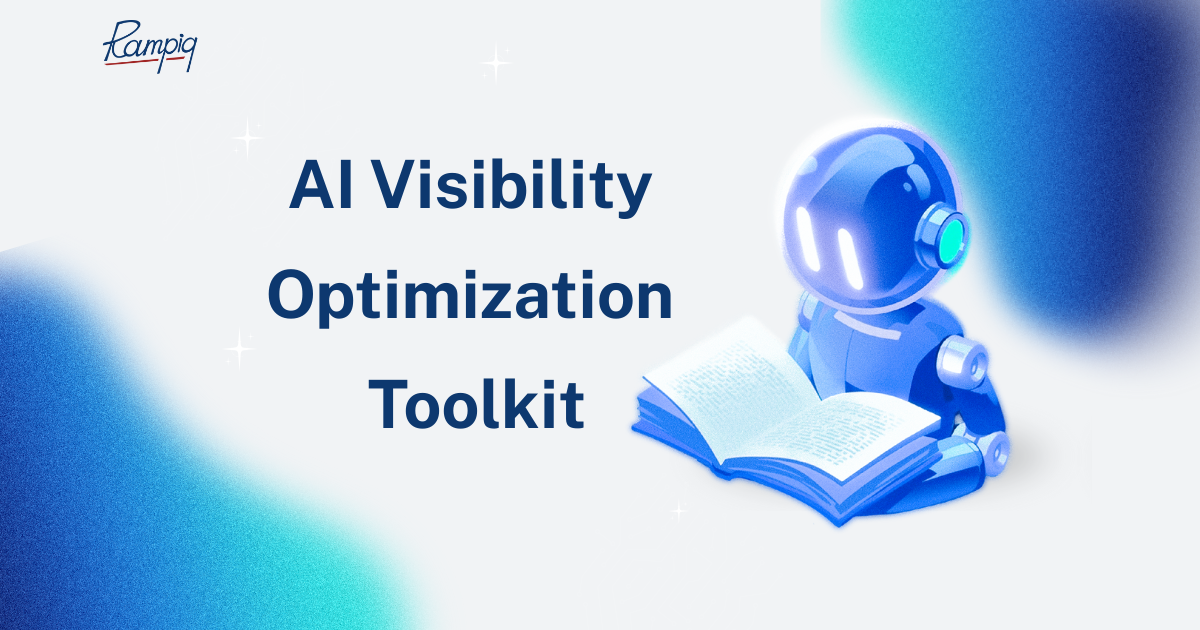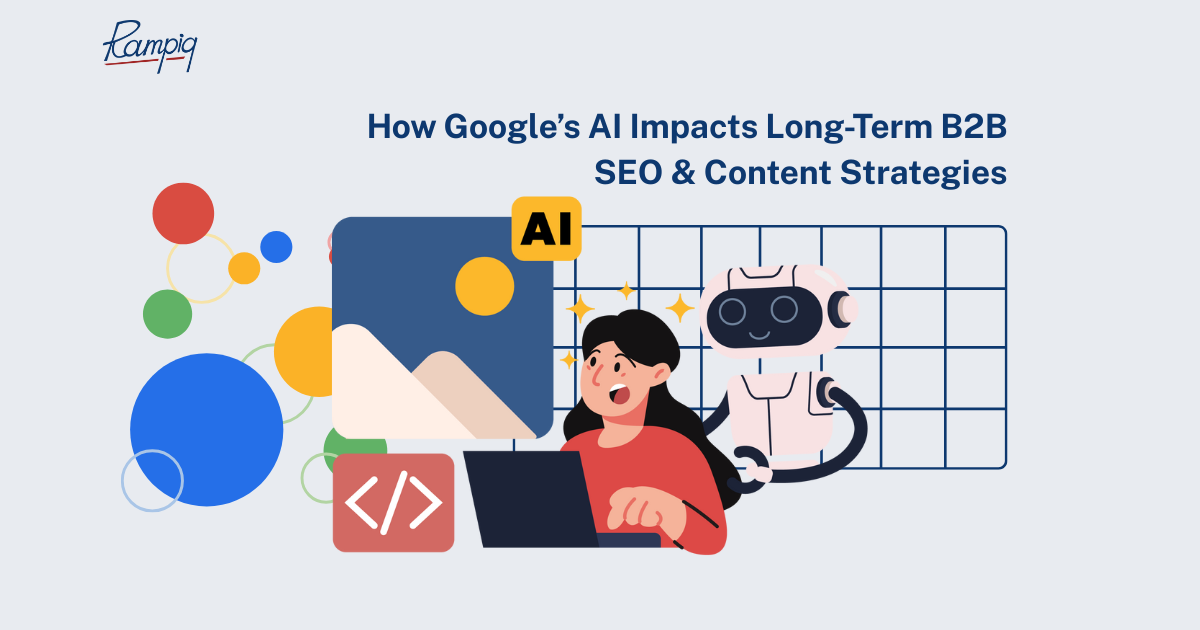1. E-E-A-T: Emphasis on First-Hand Experience
Google’s E-A-T (Expertise, Authoritativeness, and Trustworthiness) algorithm has transitioned into E-E-A-T, adding Experience as one more key factor in determining a website’s ranking. We have looked into each key element of the algorithm here – and in this section, we’ll uncover their practical meaning for your content strategy.
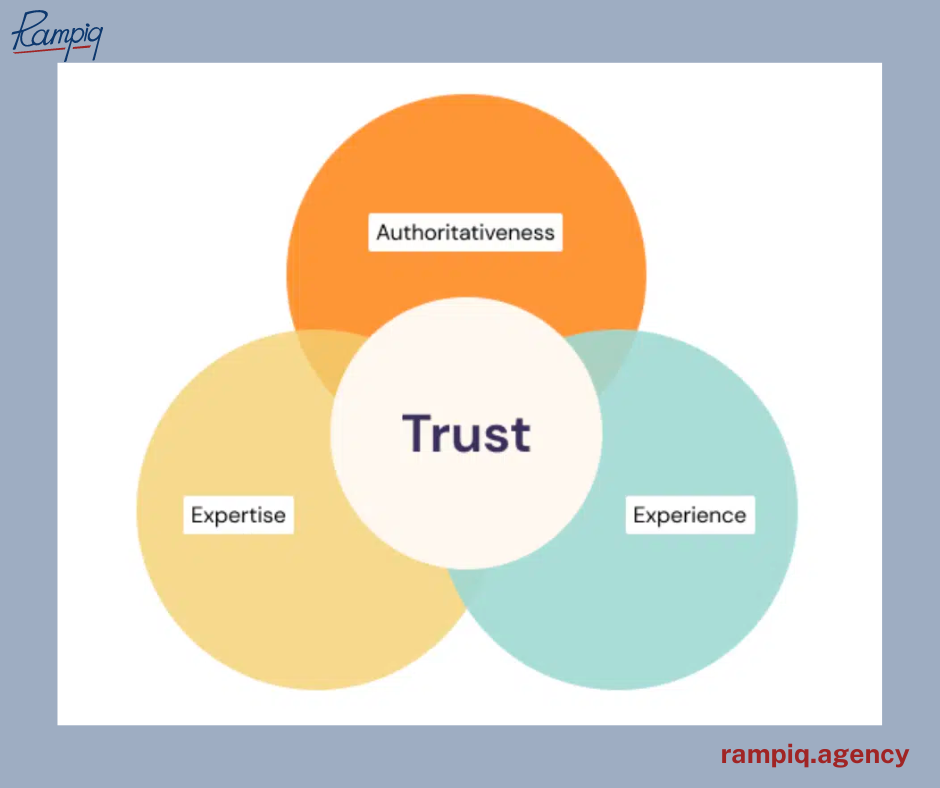
Experience
One of the key latest SEO trends, the introduction of Experience into the E-A-T algorithm makes it even more user-centric. It looks to ensure that the content is written by someone with knowledge and first-hand, practical experience on the subject.
This becomes especially important in the context of YMYL (Your Money or Your Life) pages – ones that pertain to subjects that can significantly impact an individual’s health, safety, happiness, or financial well-being.
When dealing with YMYL content, injecting a human touch is critical – in addition to factual accuracy, focus on crafting content that resonates emotionally with your audience. Incorporate personal stories, user testimonials, and experiences to make the information more relatable and trustworthy.
Also, make sure to integrate the personal experiences of the author related to the content topic. Sharing authentic anecdotes or insights gained through direct involvement adds a layer of authenticity to the content, aligning with Google’s emphasis on real-world experience.
Expertise
Beyond the standard emphasis on qualifications, Google’s E-E-A-T algorithm seeks content that doesn’t just claim expertise but demonstrates it effectively. To bolster your website’s expertise profile, encourage content creators to highlight practical experiences and real-world applications. Incorporating case studies, project outcomes, and examples of problem-solving can elevate the perceived expertise of your content.
Moreover, you can leverage structured data markup to showcase author credentials in search results – this can include author bios, certifications, and relevant achievements, reinforcing the authority of your content.
Authoritativeness
In Google’s terms, authoritativeness is the reputation of your brand within the industry, which is mainly gauged by the quality and quantity of backlinks from reputable sources. You can identify opportunities to enhance your authoritativeness by comparing your backlink profile with those of your competitors. When a competitor earns a link from a prestigious publication, it’s a signal for you to act and secure similar endorsements.
Moreover, citations from reputable sources, even without direct links, can still contribute significantly to your perceived authoritativeness. Mentions of your brand, key team members, or relevant information about your business can bolster Google’s understanding of your relevance within your niche.
Trustworthiness
Trustworthiness, as per Google itself, is the most important factor of the four. It is determined by the accuracy, accessibility, and validity of the information presented on your website. To meet the trustworthiness criteria, consider creating dedicated sections on your website that outline your comprehensive privacy policy, details on data security measures, and clear terms of service. Additionally, implementing user-generated reviews and testimonials, when appropriate, adds a layer of authenticity.
Also make sure to provide a physical location of your business, such as your central office address, as well as to implement HTTPS encryption to improve your security and trustworthiness.
2. The Rise of Author Entities
The concept of entity SEO will only continue to grow in importance in 2024, which makes author entities a must-have for tech startups. Entity SEO revolves around the optimization of entities – distinct and identifiable objects, such as people, places, organizations, concepts; or, in our case, an author.
Author entities play a central role in establishing credibility, expertise, and trustworthiness within a specific subject area, which is crucial for Google’s E-E-A-T. However, author entities shouldn’t be confused with simply adding author profiles. The entity also includes factors such as their social media presence, contributions to reputable publications, news mentions, speaking engagements, and industry recognitions.
Establishing Authors as Experts for Credibility
To establish an author entity, make sure to implement the “Person” schema markup type – and include Name, Bio, Affiliation, Email, and URLs as your baseline for information about the author. By clearly identifying authorship information, Google will recognize your entity as such, which positively contributes to your E-E-A-T.
Once the setup is complete, invest your efforts in reinforcing the authority of your entity. Verify authorship through reputable platforms or services, such as Google Authorship or social media verification badges. Contribute content to a variety of reputable platforms, including industry publications, blogs, and forums. Earn backlinks from authoritative websites and publications within your industry.
3. Adapting to Search Generative Experience (SGE)
Search Generative Experience (SGE) is one of Google Search’s latest experimental features. It uses generative AI to offer users swift and concise overviews of search topics directly on the search results page, eliminating the need to navigate to individual web pages.
While this feature is still not widely available (one can sign up to participate in the beta test here), we can already make some predictions as to how the SEO landscape will change:
- Getting Traffic From Short Questions May Be Difficult: When users find all the information they need directly in the search results, they are less likely to click through to external sites. To counter this, you may need to provide additional context or perspectives within your content to pique users’ curiosity and encourage them to visit the source for further details.
- Emphasis On Conversational Searches: SGE goes beyond providing a single answer by suggesting additional questions to prolong the search “conversation” and cater to users’ evolving queries. The feature will enable brands to feed users more of their high-quality content as long as Google finds it useful in these “conversations”. This emphasizes the importance of implementing SEO techniques tailored to phrase and broad match keywords can help ensure that your content remains visible in these extended search interactions.
- Even More Urgency To Be In Top 5 Results: SGE condenses information from selected websites and displays them in a carousel format – and most of the time it does so with the top 5 entries on the page. As users are unlikely to scroll beyond the AI Snapshot when it offers a comprehensive answer, inclusion in this carousel becomes paramount for online visibility.
- Not All Searches Will Be Affected: While SGE often provides an AI snapshot for many searches, there are instances where it’s redundant or doesn’t generate a response at all. Through various experiments, it has been identified that some sensitive queries such as health, financial, NSFW, as well as news, aren’t likely to generate a snapshot; however, that may change.
4. Implementing Answer Engine Optimization (AEO)
In the past, if a user would search for “how to bake a cake”, long-form content detailing the history of baking or the science behind cake ingredients might have dominated search results. However, with the rise of Answer Engine Optimization (AEO) we more often see immediate, actionable answers right at the top of the search results page.
Creating Concise Content
The audience seeks direct, concise answers to their queries, and search engines are adapting to meet this demand. And so should your content strategy – concise content has now become the bedrock of successful SEO.
At the same time, make sure you don’t create concise content exclusively – more nuanced, complicated topics that can show the depth of your expertise will demand comprehensive coverage.
Either way, you can optimize for AEO through these actions:
- Focus on Direct Answers: Structure your content to provide direct, concise answers to common user queries. Use formats like lists, bullet points, or step-by-step guides to present information in a clear and easily digestible manner. For example, instead of a lengthy article about the importance of fitness apps in 2024, create a “quick start guide” with essential steps for your fitness app users.
- Optimize for Featured Snippets: Featured snippets, also known as “position zero” results, are your prime targets – aim to optimize your content to appear there by formatting answers in a way that aligns with common search queries. Use schema markup, structured data, and HTML tags to signal to search engines that your content provides authoritative answers.
- Address User Intent: Intent optimization is crucial for AEO success. Understand the various intents behind user queries (e.g., informational, navigational, transactional) and tailor your content to meet those needs. If users are searching for “best fitness apps” your content should provide a curated list of affordable options with key features highlighted.
- Utilize Natural Language Processing (NLP): Google’s algorithms are increasingly sophisticated in understanding natural language queries. Incorporate conversational language and long-tail keywords that mimic how users ask questions in everyday speech. This improves the chances of your content being selected for featured snippets and other AEO-rich results.
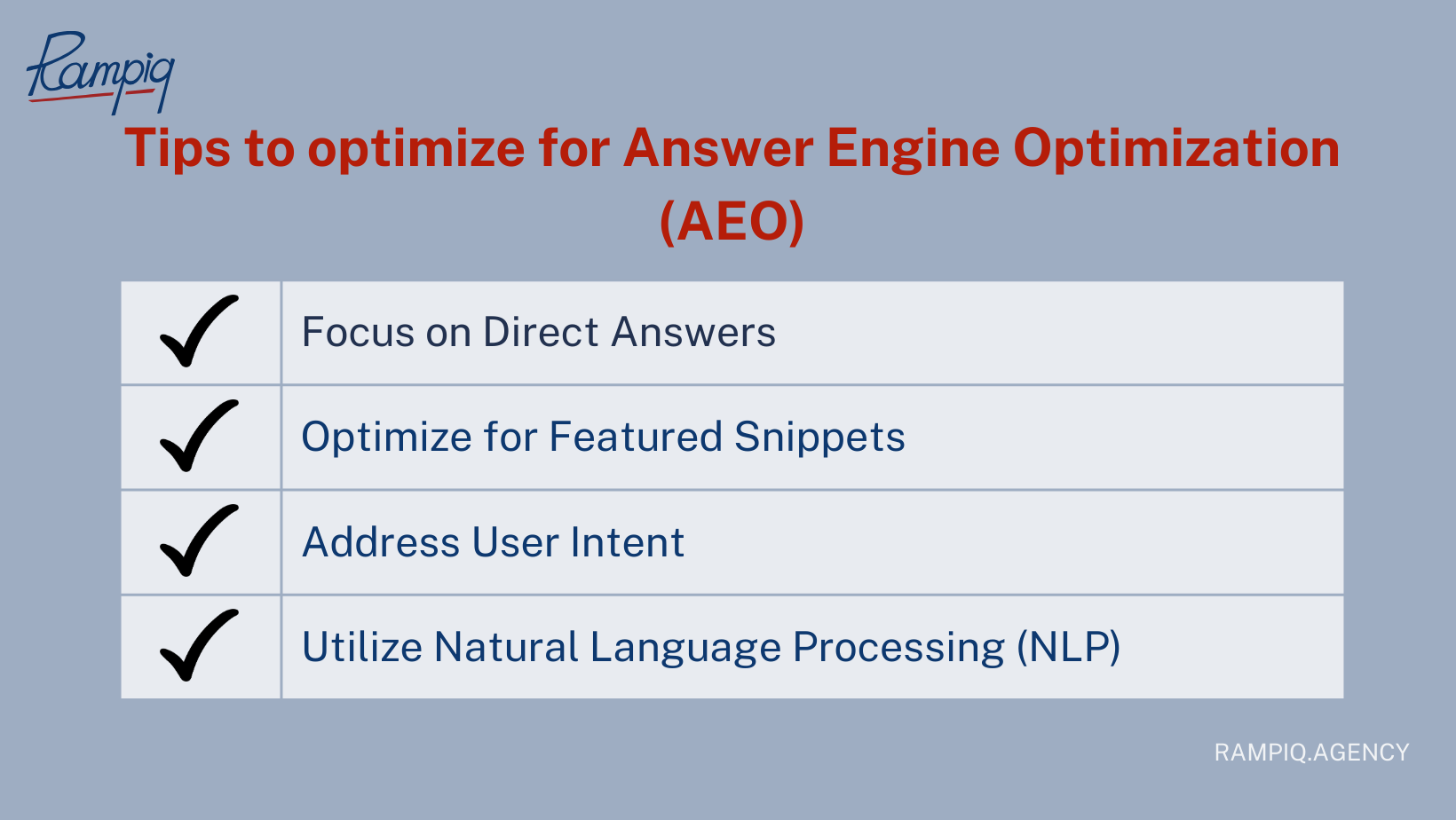
5. Building and Showcasing Topical Authority
Users demand not just information but curated expertise – that’s why search engines will prioritize content that showcases a deep understanding of specific niches. That is also because topical authority directly ties into the “Authority” aspect of the aforementioned Google’s E-E-A-T algorithm.
Content Clustering as a Topical Authority Builder
Consider employing a content clustering strategy to boost your authority. This involves creating a pillar page that serves as a comprehensive hub of information on a broad topic, surrounded by interconnected cluster content that delves deeper into specific subtopics.
For instance, if your tech startup specializes in wearable fitness trackers, your pillar page could cover overarching topics like “Benefits of Wearable Health Tech,” while the cluster content delves into more specific areas like “Heart Rate Monitoring Technology” or “Sleep Tracking Algorithms.” We will delve into content clustering in greater detail in this section as well as the next one.
Step-by-Step Guide for Boosting Authority
Here’s our recommended approach to developing comprehensive, expert content within your specific niche:
- Define Your Niche: Clearly define the niche or industry segment you want to establish authority.
- Thorough Research: Dive deep into your niche to gain a comprehensive understanding of key topics, industry dynamics, and audience preferences. Utilize various resources such as industry reports and online discussions to gather insights.
- Create Pillar Content: Develop cornerstone pieces of content that cover broad topics within your niche. These pillar pages should serve as comprehensive guides or overviews, providing valuable information to your audience.
- Identify Subtopics: Break down your pillar content into smaller, more focused subtopics or themes. Explore specific aspects or challenges related to your niche, allowing you to provide in-depth analysis and practical solutions to your audience’s needs.
- Develop Cluster Content: Create interconnected cluster content that delves deeper into each subtopic covered in your pillar content. Use a variety of formats such as blog posts, videos, and infographics to provide additional insights, examples, and tips to your audience.
- Optimize for Search Intent: Align your content with the search intent of your target audience. Analyze different types of user queries and optimize your content to address their specific preferences.
- Promote Thought Leadership: Position yourself or your brand as a thought leader within your niche – engage with your audience through guest blogging, podcast interviews, and industry collaborations to build credibility and trust.
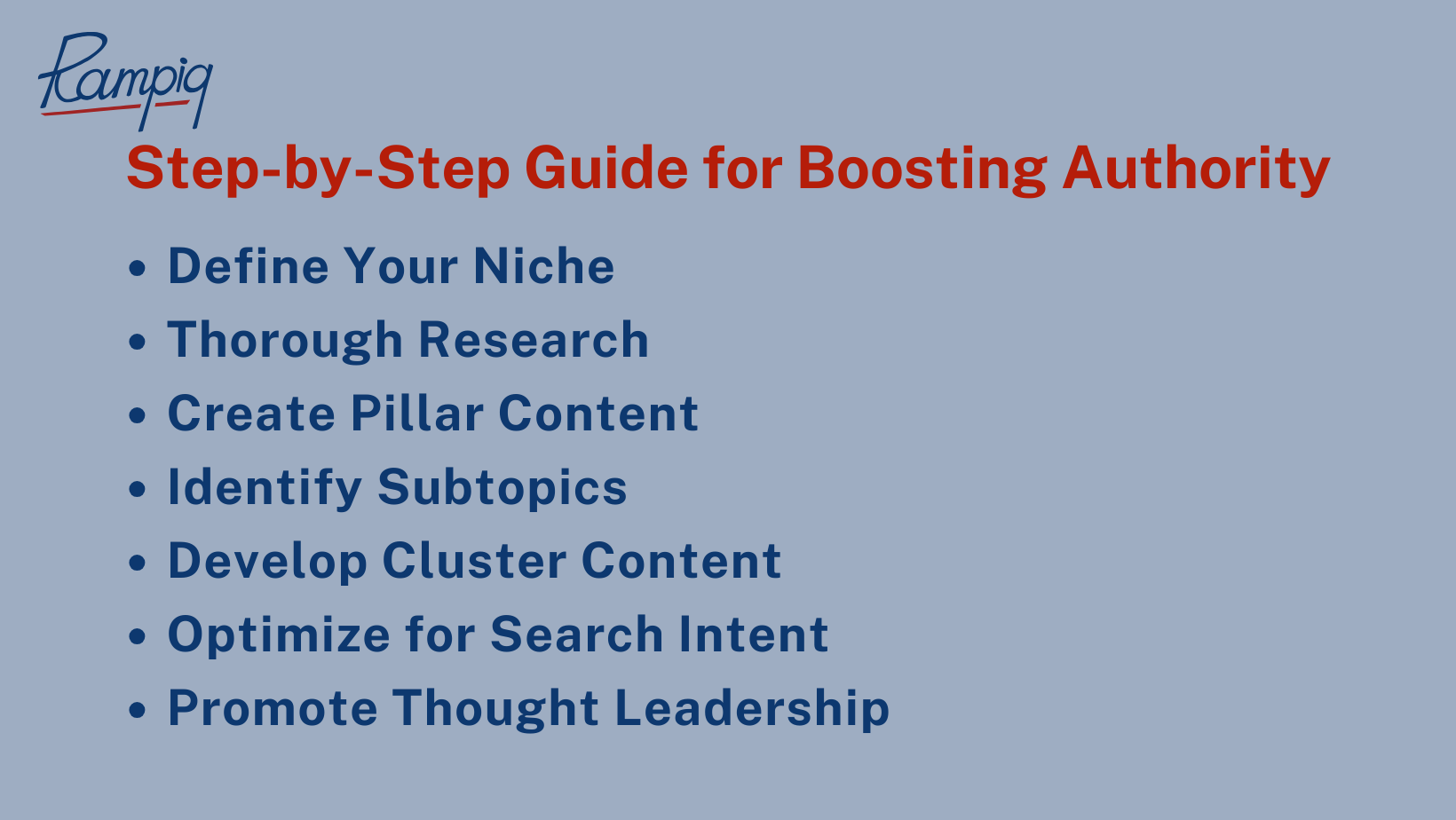
6. Utilization of Semantically Related Keywords
Google’s algorithmic evolution has seen a shift from a rigid focus on exact-match keywords to a more nuanced understanding of user intent. Google now prioritizes content that not only contains target keywords but also comprehensively addresses the broader context and intent behind user searches.
Semantically Related Keywords and Topic Clusters
Pure keyword incorporation nowadays is hardly enough – optimization involves creating a cohesive and interconnected content landscape. Here are some practical tips for optimizing your content effectively:
Advanced Semantic Research
Utilize semantic analysis tools such as SEMrush’s Keyword Magic Tool or Google’s Keyword Planner – they provide insights into related terms, synonyms, and contextual associations that can enrich your content.
Tap into user-generated content platforms like Reddit, Quora, and niche forums to uncover language patterns and colloquial expressions used by your target audience. Analyze discussions, comments, and questions related to your topic to discover valuable semantic keywords and phrases.
Conduct competitor analysis to identify semantic keywords used by top-ranking competitors in your industry. Analyze their content strategy and keyword usage to get insights for your content optimization efforts.
Comprehensive Topic Clusters
Create a pillar page that serves as the cornerstone content for a specific topic or theme within your niche. The pillar page should provide a comprehensive overview of the topic while linking to related cluster content for deeper exploration.
Implement a strategic interlinking strategy to connect your pillar page with cluster content and vice versa. Use contextual anchor text and hierarchical linking structures to guide users and search engines through your content ecosystem.
Natural Language Integration
Adopt a conversational tone in your content creation process to align with the natural language patterns of users. Use language that mirrors everyday conversations and avoids overly formal or technical terminology that may alienate readers.
Optimize your content for voice search by incorporating natural language queries and conversational phrases. Anticipate common voice search queries and structure your content to provide concise, conversational answers that address user intent directly.
7. Prioritizing People-First Content
Another one of the key trends in SEO, Google’s 2023 Helpful Content update aims to elevate content that understands user intent and anticipates their needs.
That’s why, you need to create content not just for search engines but, fundamentally, for the real people who consume it. Don’t prioritize keyword density, backlink quantity, and other technical SEO aspects over the actual relevance and usefulness of the content to human readers. This type of content will often appear disjointed and lack substance; so the focus now has to be on prioritizing user satisfaction and user engagement.
Best Practices for Creating User-Focused Content
- Genuine Problem-Solving: To truly connect with your audience, identify the pain points they experience in their daily lives or businesses. Conduct thorough research through surveys, social media listening, or customer feedback to understand their challenges better. Once you’ve identified these pain points, create content that directly addresses them – blog posts, how-to guides, or video tutorials that offer practical solutions.
- Conversational Style: Adopting a conversational tone in your content humanizes your brand and creates a stronger connection with your audience. Use everyday language that your audience can relate to, and avoid overly technical terms unless your audience consists of experts in your field. Incorporate storytelling elements into your content – share real-life examples, case studies, or personal anecdotes that illustrate your points and resonate with your audience’s experiences.
- Avoiding Over-Optimization: Avoid keyword stuffing, which can make your content sound forced and unnatural – for instance, a keyword density that goes above 3% is considered undesirable. Instead, focus on incorporating keywords where they fit contextually – and not only within the body of your text, but also headings, subheadings, and meta tags.
- Skipping Irrelevant Sections: Today’s users have limited attention spans and high expectations – avoid unnecessary fluff or filler content that detracts from your message and wastes your audience’s time. Instead, prioritize clarity and conciseness – use clear headings, bullet points, and numbered lists to break up text and make it easier to scan. If you’re writing a product review or tutorial, start with a brief overview of the main points, and then provide more detailed information for users who want to explore further.
8. Leveraging SEO Automation Tools
The rise in popularity of SEO automation tools stems from their multifaceted impact. They excel in executing repetitive tasks, minimize the margin for manual error, and also come equipped with advanced analytics capabilities.
We recommend incorporating at least some of the below automation tools for more efficient SEO:
- Screaming Frog SEO Spider: This tool automates website crawling, unveiling technical SEO issues such as broken links, duplicate content, and missing meta tags.
- Keyword Surfer: This free Chrome extension dynamically updates the SERP display, presenting information on monthly keyword search volume, its cost per click as well as domain-level traffic for competing pages.
- Yoast SEO: A WordPress plugin, Yoast SEO automates on-page optimization by providing real-time suggestions for enhancing content readability, optimizing keyword usage, and refining meta tags.
- BrightLocal: Specializing in local SEO, BrightLocal automates the management of online business listings, customer reviews, and local search performance.
- SERPWoo: Its primary strength lies in automated SERP rank tracking and reporting, which streamlines the evaluation of SEO strategies, including keyword targeting, content optimization, and link-building efforts.

9. Optimizing Product Pages With Descriptive Content
It’s not uncommon for tech company websites to feature pages with mostly basic information on their product or service as they aim to be succinct yet still informative. However, with the recent changes that encourage content-rich pages, additional descriptive content will now make a lot of difference about ranking.
By offering in-depth explanations, use cases, and technical specifications you not only help potential customers better understand your value proposition but also position the product as a solution to their specific needs and challenges.
Here’s what you can do to effectively implement long-form content on your product pages:
- Detailed Product Descriptions: Highlight not just features but delve into the benefits, use cases, and real-world applications of the product.
- Interactive FAQs Section: Anticipate and address user queries by implementing an interactive FAQs section on product pages. This not only streamlines the user experience but also demonstrates a commitment to customer understanding.
- Comparative Information Display: Provide users with a comparative analysis of your product against others in the market. Highlight unique features, specifications, or benefits, assisting users in making informed choices.
- Structured Data Markup Implementation: Boost the visibility of key product information by implementing structured data markup, such as schema.org. This enhances the likelihood of rich snippets and other search features appearing in search results, providing users with quick insights.
10. Conducting In-Depth SEO Competitor Analysis
Competitor analysis serves as the strategic compass, offering a benchmark against industry peers. Understanding the strengths and weaknesses of competitors provides invaluable insights for crafting a distinctive digital strategy.
As per our competitor analysis guide, we suggest incorporating the following practices into your competition analysis:
- Keyword Analysis: Delve into competitors’ targeted keywords using tools like SEMrush, Ahrefs, or Moz. Identify high-performing keywords and gaps in their strategy to polish your keyword targeting.
- Backlink Profile Examination: Conduct a meticulous analysis of the competition’s backlink profiles to understand the quality and quantity of their link-building efforts. Tools like Ahrefs and Majestic provide insights into backlink sources, allowing you to refine your link-building strategy.
- Content Strategy Assessment: Scrutinize competitors’ content strategies by evaluating the type, format, and depth of content they produce. Identify gaps or areas where you can provide more comprehensive and valuable content, establishing your brand as an authoritative source.
- On-Page SEO Evaluation: Assess their on-page SEO elements, including meta tags, headers, and URL structures – and identify optimization opportunities for your on-page SEO.
- Technical SEO Audit: Explore competitors’ technical SEO aspects, such as website speed, mobile responsiveness, and crawlability. Tools like Google PageSpeed Insights and Screaming Frog help in identifying areas for technical improvement.
- User Experience and Design Inspection: Evaluate the user experience and design elements of competitors’ websites. Identify aspects that contribute to a positive user experience and consider how you can enhance your own site’s design and functionality for optimum user satisfaction.
- Local SEO Examination: For businesses with a local focus, conduct a detailed analysis of competitors’ local SEO efforts. This includes assessing their Google My Business profiles, local citations, and customer reviews, enhancing your local search visibility.






